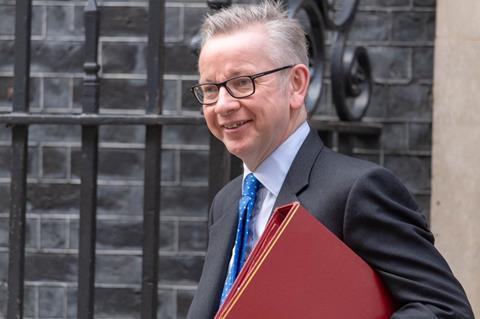Just 111 days after being sacked, Michael Gove is back. Carl Brown looks at whatŌĆÖs facing WhitehallŌĆÖs disruptor-in-chief
Which planning reforms will we get now?
Planning was probably the issue that most dominated Michael GoveŌĆÖs first stint as housing secretary last year. It is hard to believe that it was only in September 2021 that he was drafted in to replace Robert Jenrick.
His predecessorŌĆÖs downfall came about due to controversies over his ambitious plans to reform the planning system through local housing targets and a zonal system to classify land for development. The reforms, which were seen by many as reducing local communitiesŌĆÖ control over development, were blamed for the Conservative partyŌĆÖs unexpected defeat in the Chesham and Amersham by-election last summer.
Gove went straight back to the drawing board, wrapped himself in the mantle of levelling up and spreading opportunity and eventually published slimmed-down proposals as part of the Levelling-up and Regeneration Bill. The bill, currently before parliament, is more localist in focus, unlike JenrickŌĆÖs broader vision.

It would bring street votes into local areas, strengthen neighbourhood planning, remove the duty to cooperate and bring in a new infrastructure levy to partially replace Section 106 affordable housing contributions and the community infrastructure levy.
The Department for Levelling-Up, Housing and Communities (DLUHC) told Housing Today last month that the bill was not going to be scrapped but it was notably absent from government statements in Liz TrussŌĆÖ short-lived tenure and was not mentioned at all in the disastrous ŌĆ£growth planŌĆØ documents.
Truss announced her own, deregulatory planning measures, including a new planning and infrastructure bill aimed at accelerating priority infrastructure projects through reduced environmental assessments and regulation. Last month the government also opened bidding for investment zones ŌĆō areas where planning rules will be relaxed to promote growth for development.
Gove will have to work out which bits of the Truss plan for planning ŌĆō if any ŌĆō are worth keeping and the extent to which the deregulatory, pro-growth agenda she proposed is compatible with his levelling-up vision and the legislation making its way through parliament.
Meanwhile many in the housing sector, including respondents to Ą■│▄Š▒▒¶╗ÕŠ▒▓į▓ĄŌĆÖs sister title Housing TodayŌĆÖs A Fair Deal for Housing campaign, would take a better funded planning system over further reform. Gove has promised to increase planning application fees ŌĆō by 25% and 35% respectively for minor and major applications ŌĆō to boost planning departments, but there is scepticism that this will be enough to make up for under-investment in the system.
Where will Gove go next on building safety?
Arguably the area where Gove made the most progress in his first stint at DLUHC was with regard to building safety. Not only did he successfully steer his mammoth ║├╔½Ž╚╔·TV Safety Act through parliament, he also used quite aggressive tactics to persuade the largest housebuilders to pay to fix ŌĆ£life-criticalŌĆØ defects on their own buildings going back 30 years. These included amending the act to give government the power to stop firms trading if they failed to comply.
Many of the largest housebuilders signed what became known as the ŌĆ£developer pledgeŌĆØ to remediate their blocks. However, when the full text of the contract was revealed in the summer, the Home Builders Federation (HBF) said its members would not sign it due to concerns over liabilities.
Over the past few weeks, lawyers for the government and housebuilders have been going back and forth, tightening the language in the contract in a bid to ensure both parties agree that it reflects the text of the pledge.
Housebuilders want assurances that they will not become liable for work that is not necessary to fix ŌĆÖlife-criticalŌĆÖ defects and that government cannot change the contract at a future date.
An insider told Housing Today that agreement on the final wording was not ŌĆ£far offŌĆØ. However, all this means the contract looks substantially different to how it looked when Gove last saw it in the summer. If he feels the contracts are drawn too tightly, and that housebuilders will pay less than he thinks is right, the deal may yet unravel again.
Will we see real action on nutrient neutrality?
According to the HBF, around 100,000 homes are on hold due to new rules requiring developments to be ŌĆ£nutrient neutralŌĆØ. The problem has widened, with 42 new areas ŌĆō on top of the 34 originally affected ŌĆō now facing the same problem due to revised guidance in March.
In the dying days of the Johnson government, DLUHC, along with the Department for the Environment, Food and Rural Affairs (Defra) published measures intended to ease the logjam.
However, the governmentŌĆÖs package disappointed housing developers hoping for a quick resolution to the problem. The plans give water companies eight years to upgrade their water treatment works, while a mitigation scheme, which would allow housebuilders to pay to offset nutrient pollution, will not launch this year as originally suggested by Defra.
The HBFŌĆÖs chair, Stewart Baseley, dismissed the package as not matching the ŌĆ£scale or urgency of the issueŌĆØ and said it ŌĆ£would take years to implementŌĆØ.
If, as expected, the housing development market starts to slow, many in the sector will be looking to Gove to lead a fresh push to solve the nutrient logjam.
How will Gove ensure inflation does not derail the ┬Ż11.5bn affordable homes programme?
The DLUHC admitted in August that rampant inflation risked derailing the governmentŌĆÖs flagship affordable homes programme (AHP), which is expected to deliver 162,000 homes over five years. Rising costs of labour and materials mean that the affordable housing grant does not go as far as it did previously when housing associations and other bidders were putting their AHP plans together.
The DLUHC report warned that increases in inflation and interest rates were ŌĆ£sudden and unforeseenŌĆØ and ŌĆ£not reflected in initial bids and grant rateŌĆØ. Bear in mind that this was before last monthŌĆÖs disastrous mini-Budget, or growth plan, which has increased borrowing costs further.
In addition to rising borrowing costs, housing associations are also facing a proposed cap to their rent increases for 2023/24 while at the same time dealing with fire safety remediation and the need to invest in decarbonisation methods.
If the AHP looks to be in peril, Gove may need to look at ways of ensuring that affordable homes can be built, particularly if the development of homes by private housebuilders for open market sale slows as is typically the case in a recession.
Ultimately an increase in grant would do the trick, but in the current economic environment it may be tricky to persuade prime minister Rishi Sunak and new chancellor Jeremy Hunt to do this.
A Fair Deal for Housing campaign

Ą■│▄Š▒▒¶╗ÕŠ▒▓į▓ĄŌĆÖs sister title Housing Today believes the government should not back away from its manifesto pledge of building 300,000 new homes a year by the middle of the decade. We badly need more homes and a lack of supply is a major factor in creating problems of affordability for both buyers and renters.
Over the next few months, Housing Today will be exploring potential solutions to help us ramp up housebuilding to 300,000. These are likely to, include different ways of working, funding asks of government and policy ideas that could boost housebuilding.
We want to hear from you: what do you think can make a difference at a policy level?
What can the industry do better?
We believe that, with the right commitments from ministers and the industry, it is possible to build more homes and help the government to meet its objectives to ŌĆ£build beautifulŌĆØ, improve quality and safety, boost home ownership and level up the UK.
To contribute ideas to our A Fair Deal for Housing Ideas Zone database,



























No comments yet